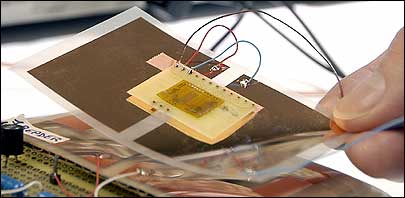Philips Research, the research arm of Philips Electronics, says it has successfully created a high-frequency (13.56 MHz) RFID tag using polymer-based chip instead of a silicon one. Paper-thin and roughly the size of a postage stamp, the tag includes a printed metallic-ink antenna. Philips used photolithography to build the integrated circuit, following steps similar to those for creating silicon chips.
The next hurdle that Philips—and other companies that are developing the technology behind polymer-based tags—face is finding a way to print the 13.56 MHz chips, rather than using conventional lithography processes. In November 2004, Andreas Ullmann, senior research scientist at German printed-electronics firm Poly IC, told RFID Journal that his company had managed to print a tag capable of operating at 125 KHz (see Developing Tomorrow’s Tags).
Antennas can already be printed using metallic inks. If complete polymer-based tags could be printed in large quantities, they could serve as a low-cost means of tagging high volumes of goods at the item level.
Philips Research, which announced its success with the 13.56 MHz polymer tag this week at International Solid-State Circuits Conference (ISSCC) in San Francisco this week, claims it is the first organization to achieve a fully functional HF polymer tag. However, PolyIC says it announced a fully functional 13.56 MHz polymer tag in October 2005.
Leo Warmerdam, senior director at Philips Research, acknowledges that Poly IC did create a functioning 13.56 MHz polymer tag before Philips did, but maintains the PolyIC tag is capable of transmitting only a single, unchangeable string of data, whereas the Philips prototype can store and transmit unique data. “The PolyIC tag can be stimulated by a reader and respond by saying, ‘Here I am,'” he explains, “but our tag can respond with a unique code, as if saying, ‘I am x.'”
The read range of the printed Philips tag is very short, measured in millimeters. Warmerdam attributes this to the type of antenna used in the demonstration (which utilizes capacitive coupling). He notes the tag could easily be built with an inductive coil antenna, used in most RFID tags, which would boost its read range to the standard for 13.56 MHz: 5 to 10 centimeters.
Once RFID tags are printable in large quantities, they can be produced directly in, or on, packaging materials and be used to identify any number of consumer or other types of products, including pharmaceuticals. While most current applications of RFID for item identification within the supply chain use ultrahigh frequency (UHF) tags, some companies, including those in the pharmaceutical industry, are considering and testing HF tags for item-level tagging.
Instead of containing a conventional, silicon-based chip, the Philips’ printed tag uses a chip built with a combination of conductive and semiconductive polymers. The main advantage of manufacturing a printed RFID tag is that the chip and antenna are printed together, eliminating the need for a separate step to join them. With conventional, silicon-based tags, the chip-to-antenna assembly is a distinct, time-consuming process. Printed tags will likely be manufactured more quickly and in larger quantities than conventional silicon-based tags.
Warmerdam says Philips has proven that polymer tags are capable of storing and transmitting data at the level of complexity needed for most passive RFID applications for product identification. He notes that the tag Philips has created contains 2,000 transistors, enabling it to store 64 bits of data. To store 96 bits, it would be need 2,500 to 3,000 transistors, which would not, he says, be significantly more difficult to create than 2,000.
The next major challenges Philips and other companies developing printed tags face, he says, are determining the best chemicals, polymers and printing processes to use, and devising a means of mass-producing the tags.
OrganicID a startup based in Colorado Springs, Colo., is also developing technology to print tags from organic polymers. Last April, it announced it had successfully printed rectifier circuits that can process radio waves at frequencies of 13.56 MHz and higher (see OrganicID Proves HF Capability of Organic Circuit). Rectifiers convert alternating current to direct current, which is used to power a tag. Then, in August of last year, IMEC, an independent nonprofit research center, developed an organic rectifier diode capable of powering a passive RFID tag operating at frequencies as high as 50 MHz (see IMEC Announces Organic Rectifier for Tags). And in mid-2005, Poly IC announced it had printed a rectifier from polymer semiconductor polythiophene that works at 13.56 MHz.


